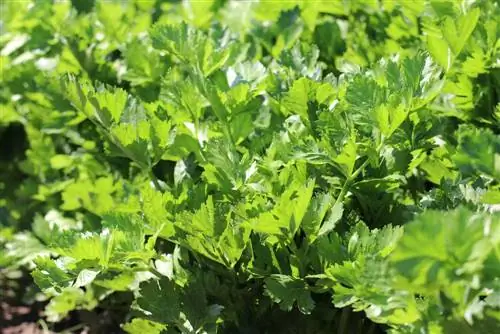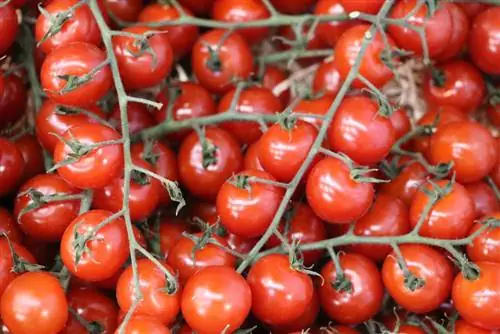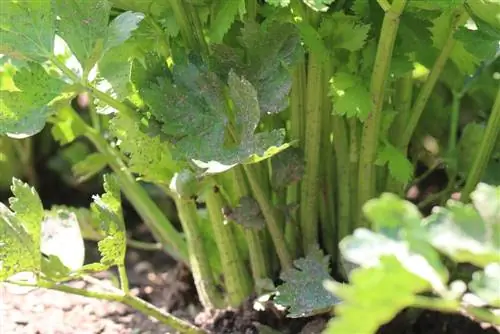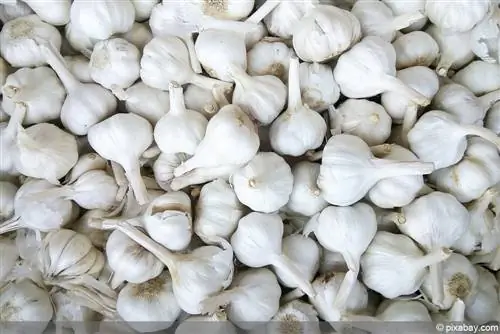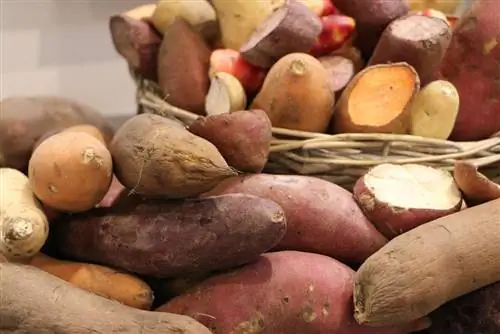- Author admin [email protected].
- Public 2023-12-17 03:39.
- Last modified 2025-06-01 06:48.
Even in ancient times, people knew about the healing power of celery. It is considered to lower blood pressure and anti-inflammatory. Above all, it tastes good and can be used in many different ways in the kitchen. Hobby gardeners have long since discovered it and grow celery - for reasons of space, mostly celery stalks and less celeriac. In order for cultivation to be successful, some preparation is required. Above all, the ground should be well prepared. If the conditions are right, there is usually nothing standing in the way of a rich harvest.
Celery or celeriac?
Anyone who decides to grow celery in their own garden must first make a fundamental decision. The question that needs to be clarified is: celery or celeriac. The two types do not differ much in terms of requirements, taste and possible uses. However, growing celery, which is often also called celery, is much easier to do. It also requires less space and can easily be grown in planters. In short: If you want to have celery in your garden, you should definitely use celery stalks.
Varieties
The trade now also offers an almost confusing variety of varieties of celery stalks. When choosing, you should pay particular attention to the fact that the variety you choose is self-bleaching. If it isn't, cultivation becomes significantly more complex. Above all, this eliminates the usual practice of placing plants in trenches and then gradually filling them with soil. Varieties that have this self-bleaching property include:
- Golden Spartan
- Pascal
- Tall Utah
- Tango
It's not for nothing that these four varieties are among the most popular and widespread. We will deal with the cultivation of such self-bleaching celery varieties later on.
Location
No matter what type of celery you choose - the plants like it warm. The reason for this is not least that the young plants in particular are extremely sensitive to cold and can therefore easily be damaged by frosty nights. Therefore, a location that is as sunny as possible is somewhat of a requirement. At best it can lie in partial shade. The location should also be well protected. In addition, the proximity to other plants and especially vegetables also plays a major role when choosing a location. Celery does not get along with everything that is grown in the garden. Under no circumstances should it be planted in a bed with the following herbs and vegetables:
- Fennel
- parsley
- Beets of all kinds
- Umbelliferous plants
Celery, on the other hand, develops very well in the immediate vicinity of cucumbers, lettuce and practically all types of cabbage. Planting in the same bed is no problem here.
Soil
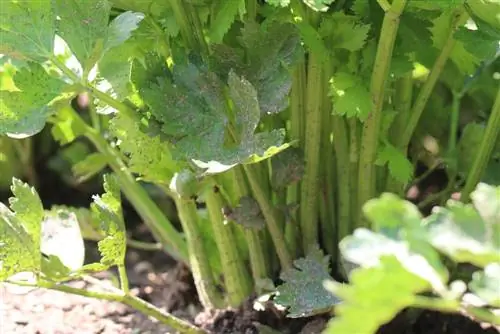
All types and varieties of celery require a very large amount of nutrients in order to thrive. It is not for nothing that we speak of so-called “heavy eaters”. It doesn't work without the most nutrient-rich soil possible. In addition, it should be clayey, contain a lot of lime and also be able to store moisture easily. This basically eliminates the need for sandy soil for growing celery. If you have mostly sandy soil in your garden, that doesn't necessarily mean that celery can't grow there too.
In order for it to work, it is of course necessary to enrich the soil before planting. Ideally, this happens in autumn and therefore before the plants are planted next spring. This gives the nutrients enough time to settle and accumulate in the soil. The soil is intensively loosened and thoroughly mixed with compost or conventional stable manure. As a rule of thumb, around four to five liters of compost or manure should be added per square meter of soil.
Tip:
In order to cover the necessary lime requirements of the celery, shell limestone, which can be purchased in specialist stores, should be added to the compost. Around 100 grams of lime per five liters of compost have proven useful.
In addition to manure or compost, horn shavings or horn meal can also be easily incorporated. To make it clear again: This applies to sandy soils. For clayey and nutrient-rich soils, this preparatory work is not absolutely necessary, but it doesn't do any harm either.
- loose, loamy, preferably nutrient-rich soil
- if the soil is sandy, enrich the soil in autumn
- Use compost or manure for this
- four to five liters of compost or manure per square meter
cultivation
Celery, like celeriac, cannot be sown directly in the garden in our latitudes. Rather, it must be kept in the apartment or in the greenhouse so that there are no unpleasant surprises later. The reason for this: Celery needs a relatively long time to grow from seed to young plant. You can assume that up to eight weeks will pass. The young plants are extremely sensitive to cold. It is therefore strongly recommended that you grow them to a point where they can survive outdoors from around May onwards.
The cultivation begins around mid-March. For this to work, it is best to let the seeds soak in water for one night. They are then sown in a planter box. In principle, small planters measuring around five by five centimeters are sufficient. Of course, you use potting soil from specialist retailers for cultivation and it presses the individual seeds into it well. It is recommended to then apply a small layer of sand, although this should not be more than half a centimeter thick. Now all you have to do is pour it well and cover it with a transparent lid. Alternatively, a transparent bag or film can be used.
There should definitely be something like a greenhouse effect. The ideal location for the planter in the next few weeks is a bright, sunny windowsill. The room temperature is also important. It should be in a range between 16 and 20 degrees Celsius and under no circumstances should it fall below the 16 degree mark. As soon as the small plants have developed two or three leaves, they must be pricked out and moved to separate pots. During further cultivation it can be a little cooler, but here too the temperature must not fall below 16 degrees.
Tip:
Before the young plants are finally planted in the bed, they should be used to the outdoors and hardened off for a few days on the terrace or balcony. They should be at least five centimeters high.
- use special potting soil
- Press seeds well into the soil, cover with a thin layer of sand and water
- cover with a transparent lid or foil
- Location: bright, sunny window seat
- Room temperature: 16 to 20 degrees
- Prick out and repot plants from around two leaves onwards
- harden off on the balcony before planting in the bed
Planting in the garden
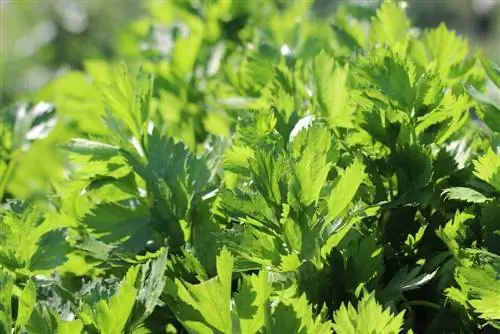
After six to eight weeks of cultivation and prior hardening, the young plants are strong enough to finally be able to move into the garden bed. This will usually be the case from around mid-May. The plants are planted in a row. The distance between individual plants and between rows should be around 20 centimeters. When planting, the depth of the planter must not be exceeded. The soil around each plant must be pressed firmly and then watered well. Note: As already mentioned, this applies to all self-bleaching varieties. If you use a different variety, holes approximately 25 centimeters deep must be dug for planting and these must be filled over time. In addition, the planting distance must then be around 50 centimeters.
Care
When caring for celery plants, two aspects are particularly important: protection from the cold and an adequate supply of nutrients and water. If it threatens to get really cold again in spring, we recommend covering it with a fleece. Regular watering and a generally moist soil are mandatory. In order to provide enough nutrients, it is recommended to give horn meal, which is lightly mixed into the soil around the plants, throughout the entire growth phase. In addition, the celery stalk must also be supplied with sodium and boron. Watering with cold, well-stale cooking water (potato water) or a special s alt mixture is suitable for this.
Tip:
Dissolve a teaspoon of sea s alt in ten liters of water and water the plants every month.
Celery is relatively insensitive to diseases and pests. An infestation with the Septoria leaf spot fungus may occur. This can be prevented by spacing the individual plants far enough apart. If necessary, you can also water with a horsetail broth. Once the fungus has appeared, it is difficult to combat. You have to expect a smaller harvest.
Harvest
Under normal circumstances, celery can be harvested in October. Harvesting should definitely take place before the first frost, as the plants would not survive it. The harvest itself is very simple: you pull the entire plant out of the ground by its leaves - done. In order to store the celery stalks as professionally as possible, the stalks should be cut at a distance of about ten centimeters above the first leaf branch. The ideal storage location is a cool cellar - especially if you pack the celery and roots pole by pole in a box filled with moist sand. When stored this way, it should remain fresh and edible for around eight weeks. Alternatively, you can of course simply put it in the fridge. It stays there for about a month.

